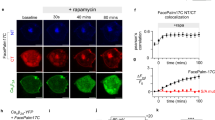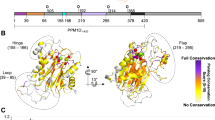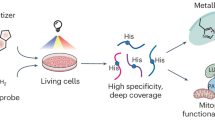Abstract
This proteomic protocol purifies and identifies palmitoylated proteins (i.e., S-acylated proteins) from complex protein extracts. The method relies on an acyl-biotinyl exchange chemistry in which biotin moieties are substituted for the thioester-linked protein acyl-modifications through a sequence of three in vitro chemical steps: (i) blockade of free thiols with N-ethylmaleimide; (ii) cleavage of the Cys-palmitoyl thioester linkages with hydroxylamine; and (iii) labeling of thiols, newly exposed by the hydroxylamine, with biotin–HPDP (Biotin-HPDP-N-[6-(Biotinamido)hexyl]-3′-(2′-pyridyldithio)propionamide. The biotinylated proteins are then affinity-purified using streptavidin–agarose and identified by multi-dimensional protein identification technology (MuDPIT), a high-throughput, tandem mass spectrometry (MS/MS)–based proteomic technology. MuDPIT also affords a semi-quantitative analysis that may be used to assess the gross changes induced to the global palmitoylation profile by mutation or drugs. Typically, 2–3 weeks are required for this analysis.
This is a preview of subscription content, access via your institution
Access options
Subscribe to this journal
Receive 12 print issues and online access
$259.00 per year
only $21.58 per issue
Buy this article
- Purchase on SpringerLink
- Instant access to full article PDF
Prices may be subject to local taxes which are calculated during checkout





Similar content being viewed by others
References
Huang, K. & El-Husseini, A. Modulation of neuronal protein trafficking and function by palmitoylation. Curr. Opin. Neurobiol. 15, 527–535 (2005).
Resh, M.D. Palmitoylation of ligands, receptors, and intracellular signaling molecules. Sci. STKE 2006, re14 (2006).
Linder, M.E. & Deschenes, R.J. Palmitoylation: policing protein stability and traffic. Nat. Rev. Mol. Cell Biol. 8, 74–84 (2007).
Roth, A.F. et al. Global analysis of protein palmitoylation in yeast. Cell 125, 1003–1013 (2006).
Roth, A.F., Wan, J., Green, W.N., Yates, J.R. & Davis, N.G. Proteomic identification of palmitoylated proteins. Methods 40, 135 (2006).
Drisdel, R.C. & Green, W.N. Labeling and quantifying sites of protein palmitoylation. Biotechniques 36, 276–285 (2004).
Link, A.J. et al. Direct analysis of protein complexes using mass spectrometry. Nat. Biotechnol. 17, 676–682 (1999).
Washburn, M.P., Wolters, D. & Yates, J.R. 3rd. Large-scale analysis of the yeast proteome by multidimensional protein identification technology. Nat. Biotechnol. 19, 242–247 (2001).
Aebersold, R. & Mann, M. Mass spectrometry-based proteomics. Nature 422, 198–207 (2003).
Liu, H., Sadygov, R.G. & Yates, J.R. 3rd. A model for random sampling and estimation of relative protein abundance in shotgun proteomics. Anal. Chem. 76, 4193–4201 (2004).
Ghaemmaghami, S. et al. Global analysis of protein expression in yeast. Nature 425, 737–741 (2003).
Roth, A.F., Feng, Y., Chen, L. & Davis, N.G. The yeast DHHC cysteine-rich domain protein Akr1p is a palmitoyl transferase. J. Cell Biol. 159, 23–28 (2002).
Lobo, S., Greentree, W.K., Linder, M.E. & Deschenes, R.J. Identification of a Ras palmitoyltransferase in Saccharomyces cerevisiae. J. Biol. Chem. 277, 41268–41273 (2002).
Smotrys, J.E. & Linder, M.E. Palmitoylation of intracellular signaling proteins: regulation and function. Annu. Rev. Biochem. 73, 559–587 (2004).
Ducker, C.E. et al. Discovery and characterization of inhibitors of human palmitoyl acyltransferases. Mol. Cancer Ther. 5, 1647–1659 (2006).
Link, A.J., Jennings, J.L. & Washburn, M.P. Analysis of protein composition using multidimensional chromatography and mass spectrometry. in Current Protocols in Protein Science, (eds. Coligan, J.E., Dunn, B.M., Speicher, D.W. & Wingfield, P.T.) chapter 23, 23.1.1–23.1.25 (John Wiley and Sons, Inc., Hoboken, New Jersey, 2003).
Bern, M., Goldberg, D., McDonald, W.H. & Yates, J.R. 3rd . Automatic quality assessment of peptide tandem mass spectra. Bioinformatics 20 (Suppl 1): I49–I54 (2004).
Eng, J.K., McCormack, A.L. & Yates, J.R. 3rd. An approach to correlate tandem mass spectral data of peptides with amino acid sequences in a protein database. J. Am. Soc. Mass Spectrom. 5, 976–989 (1994).
Tabb, D.L., McDonald, W.H. & Yates, J.R. 3rd . DTASelect and contrast: tools for assembling and comparing protein identifications from shotgun proteomics. J. Proteome Res. 1, 21–26 (2002).
Wessel, D. & Flugge, U.I. A method for the quantitative recovery of protein in dilute solution in the presence of detergents and lipids. Anal. Biochem. 138, 141–143 (1984).
Acknowledgements
We thank John R. Yates 3rd (The Scripps Research Institute, La Jolla, CA) for his help in the original development of this protocol. The MuDPIT proteomic technology developed by his laboratory proved indispensable to this analysis in terms of its high capacity and the facile quantitative analysis that it affords. The development of this technology was supported by NIH GM065525 (N.G.D.) and NIH RR11823 (John R. Yates 3rd).
Author information
Authors and Affiliations
Corresponding author
Ethics declarations
Competing interests
The authors declare no competing financial interests.
Rights and permissions
About this article
Cite this article
Wan, J., Roth, A., Bailey, A. et al. Palmitoylated proteins: purification and identification. Nat Protoc 2, 1573–1584 (2007). https://doi.org/10.1038/nprot.2007.225
Published:
Issue date:
DOI: https://doi.org/10.1038/nprot.2007.225
This article is cited by
-
Cyclical palmitoylation regulates TLR9 signalling and systemic autoimmunity in mice
Nature Communications (2024)
-
Targeting ZDHHC21/FASN axis for the treatment of diffuse large B-cell lymphoma
Leukemia (2024)
-
D6PK plasma membrane polarity requires a repeated CXX(X)P motif and PDK1-dependent phosphorylation
Nature Plants (2024)
-
Limb-Clasping Response in NMDA Receptor Palmitoylation-Deficient Mice
Molecular Neurobiology (2024)
-
Global profiling of protein S-palmitoylation in the second-generation merozoites of Eimeria tenella
Parasitology Research (2024)



